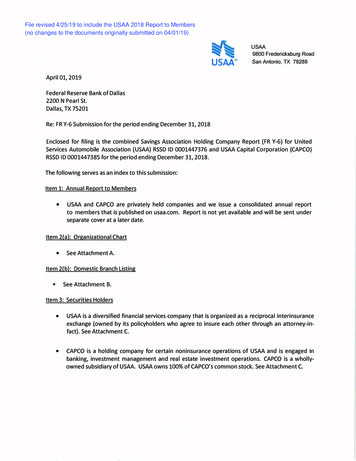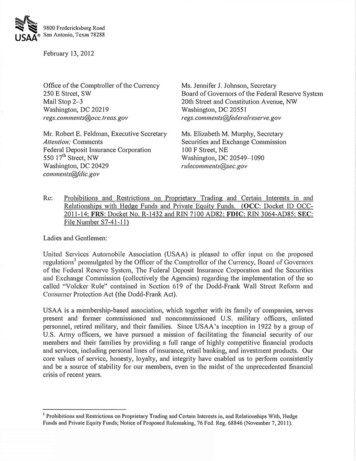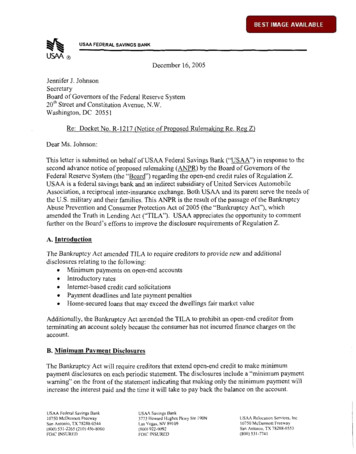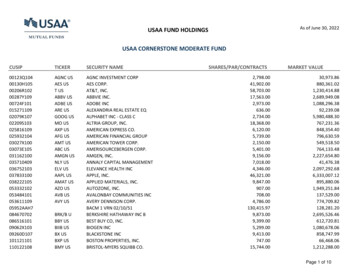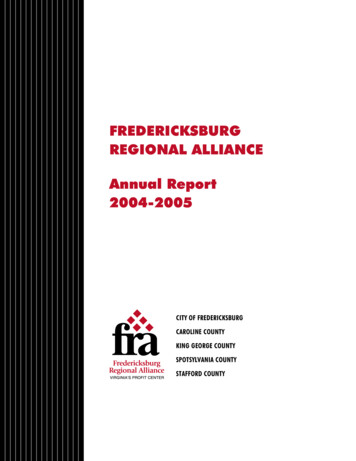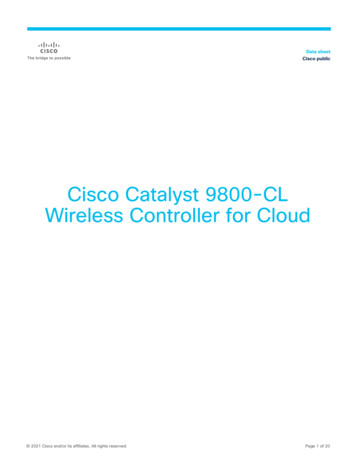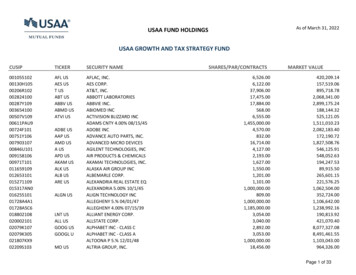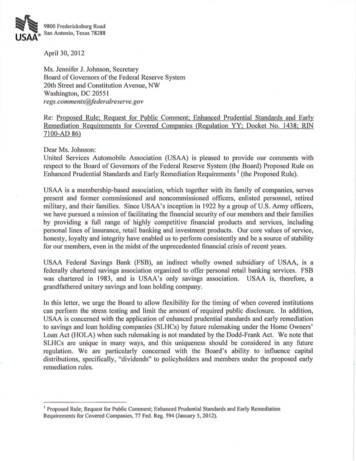
Transcription
9 8 0 0 Fredericksburg RoadUSAA San A n t o n i o , T e x a s 7 8 2 8 8April 30, 2012Ms. Jennifer J. Johnson, SecretaryBoard of Governors of the Federal Reserve System20th Street and Constitution Avenue, NWWashington, DC 20551regs.comments@federalreserve.govRe: Proposed Rule; Request for Public Comment; Enhanced Prudential Standards and EarlyRemediation Requirements for Covered Companies (Regulation YY; Docket No. 1438; RIN7100-AD 86)Dear Ms. Johnson:United Services Automobile Association (USAA) is pleased to provide our comments withrespect to the Board of Governors of the Federal Reserve System (the Board) Proposed Rule on(the ProposedRule).Enhanced Prudential Standards and Early Remediation Requirementsfootnote1.USAA is a membership-based association, which together with its family of companies, servespresent and former commissioned and noncommissioned officers, enlisted personnel, retiredmilitary, and their families. Since USAA's inception in 1922 by a group of U.S. Army officers,we have pursued a mission of facilitating the financial security of our members and their familiesby providing a full range of highly competitive financial products and services, includingpersonal lines of insurance, retail banking and investment products. Our core values of service,honesty, loyalty and integrity have enabled us to perform consistently and be a source of stabilityfor our members, even in the midst of the unprecedented financial crisis of recent years.USAA Federal Savings Bank (FSB), an indirect wholly owned subsidiary of USAA, is afederally chartered savings association organized to offer personal retail banking services. FSBwas chartered in 1983, and is USAA's only savings association. USAA is, therefore, agrandfathered unitary savings and loan holding company.In this letter, we urge the Board to allow flexibility for the timing of when covered institutionscan perform the stress testing and limit the amount of required public disclosure. In addition,USAA is concerned with the application of enhanced prudential standards and early remediationto savings and loan holding companies (SLHCs) by future rulemaking under the Home Owners'Loan Act (HOLA) when such rulemaking is not mandated by the Dodd-Frank Act. We note thatSLHCs are unique in many ways, and this uniqueness should be considered in any futureregulation. We are particularly concerned with the Board's ability to influence capitaldistributions, specifically, "dividends" to policyholders and members under the proposed earlyremediation rules.Proposed Rule; Request for Public C o m m e n t ; Enhanced Prudential Standards and Early R e m e d i a t i o nR e q u i r e m e n t s for C o v e r e d C o m p a n i e s , 7 7 Fed. Reg. 5 9 4 (January 5, 2 0 1 2 ) .endoffootnote.
Page 2A. Timing of stress testsThe Proposed Rule provides that the annual stress test is to be based on data as of September 30,and requires submission of stress test results to the Board on or before January 5 of the followingyear. However, in explaining the Proposed Rule, the Board states that the sets of economic andfinancial conditions ("scenarios") to be utilized by SLHCs to perform stress testing will beprovided by the Board no later than mid-November. If the scenarios are provided in November,the SLHC will have only two months to execute the stress tests, validate results, socialize withsenior management and the board of directors, prepare action plans, and document the results inthe required report to the Board. Requiring the testing and reporting to take place during thefourth quarter of the year also is likely to strain the resources of most institutions. Furthermore,the fourth quarter timing may render it very difficult for covered institutions to makemodifications to institution strategic and operational plans for the following year that address anyissues identified in the test results. We recommend that the timing for performing the stresstesting and reporting results be lengthened and that covered institutions be permitted to choosewhen during the year they will conduct the stress testing and reporting exercise. At a minimum,the scenarios should be provided to covered institutions not later than September 30.B. Limit public disclosure of stress test results.The Dodd-Frank Act mandate for public disclosure of the results of annual stress tests is verygeneral. The statute simply states that the Board may prescribe, by regulation, periodic publicWe believethe general and non-mandatory nature of this statutory requirement isdisclosures.footnote2.an acknowledgment that any public disclosure of covered institution stress test results creates thepotential for unintended and unwarranted loss of consumer or marketplace confidence inparticular covered institutions or in the nation's financial system generally. The statute enables,but does not require specific public disclosure. The language is an acknowledgment that theBoard is in the best position to prudently define the nature and extent of such disclosure. A fairinterpretation of the language is that the Board publicly disclose aggregate stress testing resultsbut not individual institution results. Such disclosure would be a prudent course for instillingpublic confidence rather than highlighting any one institution's test results, which could haveunintended or exacerbated negative consequences.In the alternative, if the Board does require disclosure of individual stress test results, we urgethe Board to require only the level of detail absolutely necessary to further the policy purpose, asappropriate, for the public disclosure. The stress testing requirements are new and untested. Atleast initially, we expect that the Board and SLHCs will engage in an iterative process ofperforming the stress testing exercise, reviewing the test results, adjusting the testingmethodologies and retesting so that accurate and meaningful test results are produced. TheBoard and all covered institutions also will need to ensure the methodologies and practices usedto conduct the stress tests are consistent so that even when general information about the stresstest results is published by the covered institution, that information is comparable to stress testresults information published by other covered institutions. Thus, public disclosure of suchresults should be very high level at the outset. With experience and, perhaps more importantly,Dodd-Frank Act Section165(f)endoffootnote.
general public familiarity with covered institution stress testing initiatives, the public disclosurecould perhaps be prudently expanded over time.page3.C. Application of BHC and SIFI enhanced prudential standards and early remediationto SLHCs is inappropriate.The Proposed Rule release indicates that the Board intends to issue a separate proposal for noticeand comment to initially apply enhanced prudential standards and early remediationrequirements to all SLHCs with substantial banking activity. As a savings and loan holdingcompany, USAA has significant concerns regarding the implications of any future extension ofthe Proposed Rule to SLHCs.1. The Dodd-Frank Act does not mandate enhanced prudential standards for SLHCs.The Dodd-Frank Act Section 165(a)(1) requires the Board to apply enhanced prudentialstandards to (1) nonbank financial companies supervised by the Board and (2) certain bankholding companies (BHCs). The term "nonbank financial companies supervised by the Board"means those nonbank financial companies that the Financial Stability Oversight Council hasthat aredetermined under section 113 should be supervised by the Boardfootnote3. now commonlyreferred to as systemically significant financial institutions or SIFIs.The Dodd-Frank Act does not mandate issuing enhanced prudential standards to any otherfinancial companies, including SLHCs. If Congress had meant for the Board to establish a singleset of enhanced standards to apply to all financial companies including SLHCs, it would not havedefined a SIFI subset of financial institutions.2. SLHCs are fundamentallydifferent from SIFIs and BHCs.Congress recognized that enhanced prudential standards are not appropriate for all financialcompanies.A grandfathered SLHC like USAA is vastly different from those large,interconnected institutions that will meet the definition of SIFI. Moreover, the business and riskprofile of SLHCs is fundamentally different from that of BHCs.USAA is both an SLHC - by virtue of being the ultimate parent of USAA FSB - and anoperating property and casualty insurance company. USAA writes exclusively personal lines ofproperty and casualty insurance, primarily automobile, homeowners, renters and personalproperty insurance. Generally speaking, historically USAA has earned over half of its revenuefrom its property and casualty operations. Therefore, although USAA meets the test for"substantial banking activity" as set forth in the Proposed Rule, USAA remains very much aninsurance company.As a savings association, USAA FSB is a retail bank and a residential home and auto lenderserving our military members. Commercial banks typically extend loans to businesses as well asDodd-Frank Act S e c t i o n1 0 2 ( a ) ( 4 ) ( D ) . e n doffootnote.
consumers, which can result in risk concentrations within entities and particular industries,whereas, lending to consumers generally mitigates concentration risk.page4.As a personal lines insurance company and the holding company for a retail depositoryinstitution, USAA is not interconnected to the financial industry like many other banks. In fact,USAA does not meet the SIFI Stage 1 uniform quantitative thresholds established by the FSOCand therefore is not likely to be designated as systemically significant.footnote4.We appreciate that the Board is tasked with ensuring the safety and soundness of financialinstitutions. However, USAA is not systemically interconnected to the banking system in thesame way as those companies meeting the definition of SIFI and is not subject to the samecapital and liquidity risks as large BHCs. Therefore, because we do not present the same risks asBHCs and SIFIs, applying the same set of enhanced prudential standards is not particularlyvaluable and would be unduly burdensome.D. Consider the unique aspects of SLHCs and insurers.USAA believes we are in a unique situation in the financial industry by being both an insurer andparent to a depository institution. Our mission is to be the financial services provider of choicefor the military community. Therefore, it is fundamental that we offer a spectrum of insurance,banking and other financial services products to our members. Military servicemembers havespecialized needs, and we believe having one financial institution to respond to those needs isinvaluable.Although we believe SLHCs should not be subject to enhanced prudential standards, if the Boarduses HOLA to implement enhanced prudential standards on SLHCs, it is important that theBoard consider certain unique aspects of insurer SLHCs. Particularly, we urge the Board to takeinto account the unique business, risk and liquidity profiles of insurer SLHCs as well as theirnon-bank characteristics.1. DiversifiedBusinesses.In contrast to most BHCs and SLHCs, unitary SLHCs operate diversified businesses outside thebanking industry as permitted by HOLA. For USAA, our insurance enterprises represent asignificant portion of our consolidated revenue. The same would not be true for BHCs, whichoperate primarily in the banking industry. Unlike banking entities, the financial strength ofproperty and casualty insurance companies is equally, if not more so, affected by the liabilitieson the balance sheet (principally related to insurance claims) and the pricing of insurance risks inthe form of policyholder premiums. Risks of personal property and casualty insurers occursomewhat independently of the economic cycle and vary most significantly by geography. Bankrisks are highly correlated with the economic cycle and therefore, during a crisis, there isincreased insolvency risk for depository institutions with asset concentrations in affected areas.In this way, unitary SLHC's diversified businesses are a considerable benefit.1 2 C . F . R . § 1 3 1 0 ( 2 0 1 2 ) .endoffootnote.
Page 52. Risk and Liquidity.All insurance companies must deal with the risk that earned and retained premiums may notcover the cost of future and potential claims. Therefore insurance companies are subject toextensive regulation. A primary goal of this regulation is to ensure that investment portfoliosprovide adequate diversification and liquidity to preserve capital and pay claims.Personal line property and casualty insurers rely primarily on premiums and capital retention tosupport the risk presented by insurance liabilities and investment portfolios. Insurance companyportfolio assets are mostly comprised of fixed income and highly marketable securities in adiversified portfolio. Typically, only a limited portion of insurance company portfolio assets areat risk at any time given the highly regulated nature of insurance company balance sheets.Property and casualty insurance companies have a lack of pro-cyclicality of capital. While somebanks may build capital buffers in strong economic times to prepare for economic downturns,property and casualty insurance companies build capital in proportion to the risk that naturalcatastrophes may impact claims. Threats from the natural environment do not coincide with theeconomic cycle.In addition, the capital framework of property and casualty insurance companies is designed tocapture unique insurance, liquidity and investment risks. Insurers manage these risks byemploying underwriting, pricing adjustments, catastrophe management and loss reserving.These tools enable insurance companies to manage risk exposures much more effectively thanthrough monthly liquidity stress testing. To the extent liquidity stress testing is applied to aninsurer SLHC, we suggest using an annual liquidity stress test for the insurance operations(updated for material changes such as catastrophes, reinsurance, market disruptions orunderlying business changes) and overlaying that information with more frequent (e.g., monthly)bank liquidity stress tests.3. Bank-centric Basel III metrics.Finally, we note that the current Basel III metrics for capital and liquidity are not built forinsurers. The capital requirements for sufficiency and composition are applicable to banks. Theliquidity coverage ratio and net stable funding ratio requirements are structured around bankbalance sheets and are not centered around an insurance company's business model nor theinsurer's potential "uses" of liquidity (in a normal or stressed environment) - that is, to payclaims. Insurer SLHCs cannot rely on these bank-centric ratios without some adjustment orconsideration.E. Exempt dividends to members and policyholders from the definition of capitaldistributions.If the early remediation portion of the Proposed Rule is applied to SLHCs by separaterulemaking, USAA, as an insurer, has concerns about the broad definition of capital
distributions. The definition of capital distributions in the Proposed Rule includes "any similartransaction that the Federal Reserve determines to be in substance a distribution of capital."footnote5.Like many insurance companies, USAA pays "dividends" and other similar distributions to itspolicyholders and members.As a state-regulated insurer, USAA's payment of thesedistributions is subject to regulation under state laws, primarily by the Texas Department ofInsurance. USAA's decision to pay dividends and other similar distributions is influenced by anumber of factors including the association's financial performance, claims and catastrophecosts, the investment market and the ongoing financial strength of the association.page6.We are concerned that such policyholder distributions could fall within the broad language of theproposed definition of capital distributions because they are approved annually by the board ofdirectors and funded from annual earnings and policyholder surplus. These distributions,however, are unlike stock dividends. First, these distributions are not based on ownership rights,but represent a return of insurable premiums paid by policyholders, generally rendering them taxfree to the policyholder. Second, because policyholder distributions effectively decrease the costof insurance to the consumer, these dividends impact consumer pricing and insurercompetitiveness.Insurance is a highly competitive industry and insurers compete on price.Policyholderdividends help insurance companies keep the effective cost of insurance low for customers.Insurers base premium costs on estimated expenses, including claims and catastrophe costs. If,for example, an insurer has a year with less than expected catastrophe costs that result in excesspremiums, rather than keep this excess earned surplus, policyholder distributions allow theinsurer to pay the excess back to its policyholders. Therefore, the curtailing of insurer SLHCdistributions effectively increases the cost of insurance for consumers.Further, policyholder distributions help maintain strong customer relations. We believe a returnof premium through policyholder dividends and distributions builds goodwill and encourages ourmembers to renew their coverage. Maintaining insurance customers not only benefits andstrengthens the SLHC, but decreases costs for consumers. Keeping an existing policyholder isless costly than adding a new customer.Finally, imposing regulations on insurer SLHC distributions, which would not apply to nonSLHC insurers, puts insurer SLHCs at a competitive disadvantage. Strong insurance operationshave a positive impact on an insurer SLHC and the depository institution it supports. Wetherefore urge the Board to expressly exempt dividends and other distributions to members andpolicyholders from the broad definition of capital distributions.F. Risk ManagementUSAA currently has a robust risk management process, which includes oversight byvarious committees of the board of directors, in particular the audit and financial committee.E n h a n c e d Prudential Standards, 7 7 Fed. Reg. at 661 ( d e f i n i n g capital distribution in R e g u l a t i o n Y Y S e c t i o n2 5 2 . 1 6 1 ( c ) ) .endoffootnote.
Page 7USAAbelieverequestmaimerbelieves this structure is best suited to monitor and assess enterprise-wide risks. Wea stand-alone risk committee is not the most effective means of risk oversight, and wethat the Board give flexibility to companies to structure risk management oversight in athat best fits their governance, strategy and risk profiles.G. Allow SLHCs an opportunity to comment on future proposed rulemakings.If the Board extends the requirements of the Proposed Rule to SLHCs as suggested in theProposed Rule Supplementary Information, we respectfully request the Board allow SLHCs andimpacted entities sufficient opportunity to comment on the specific implications of such a rule.USAA appreciates the important role the Board plays in providing for the safe and soundoperation of the banking system in the United States. We appreciate the Board's considerationof our comments and look forward to working with the Board in the future. Should you haveany questions or wish further clarification or discussion of our points, please contact MichaelBroker at 210-498-0029.Sincerely, signed.Steven Alan BennettExecutive Vice PresidentGeneral Counsel & Corporate Secretary
USAA 9800 Fredericksburg Road San Antonio, Texas 78288 . April 30, 2012 . Ms. Jennifer J. Johnson, Secretary Board of Governors of the Federal Reserve System . 20th Street and Constitution Avenue, NW Washington, DC 20551 . regs.comments@federalreserve.gov . Re: Proposed Rule; Request for Public Comment; Enhanced Prudential Standards and Early
